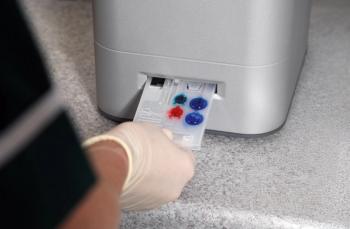
Investing in veterinary imaging: A tale of two ultrasounds
When it comes to purchasing ultrasound equipment, you want the best of machines, not the worst of machines. It's a far, far better thing to do your research. Heres one clinic's guidance on how to approach this sizable investment.
(Shutterstock)About 16 months ago, Sheep Draw Veterinary Hospital in Greeley, Colorado, where I worked, decided to purchase an ultrasound machine. Based on the number of clients they were referring out for the procedure, the fact that 40 to 45 percent of clients declined an ultrasonographic exam when it was recommended because they had to go to another facility, and the fact that it was a seven- to 10-day wait to have a mobile radiologist come to the clinic, the practice manager Ethan Miles and the practice owner decided to invest $20,000 in an eight-year-old, used, high-end, cart-based machine from Colorado State University. The cost included extra probes and two-day training workshops for two doctors and one technician, valued at $3,000.
How to avoid purchasing pitfalls
When you are about to plunk down a large amount of money for a capital investment such as an ultrasound machine, it literally pays to do your research. Karen Felsted, CPA, MS, DVM, CVPM, CVA, has a three-step process:
Step 1. Before you even open a catalogue or talk to a rep, nail down your expectations by asking yourself:
- Why are you investing in an ultrasound?
- What do you expect out of it financially?
- Who is going to be using it and why?
- How will it positively impact your practice?
- When do you want to have it paid off and turning a profit?
- How often do you expect to use it?
- How much do you want to spend and why? Include in your spending the cost of training and personnel.
The most common reasons veterinarians want to invest in an ultrasound is to improve the quality of care, increase efficiency and increase profitability.
Step 2. Once you've nailed down your expectations, then and only then start to look at models and brands. When you look, filter everything through your expectations that you already nailed down in step one. Get a solid idea of the machine's capability, future repair costs and other peripheral costs. Dr. Felsted recommends talking to other veterinarians already using the model and asking them for feedback on what they like and don't like.
Step 3. Run a cost-profit analysis on the ultrasound machine to give you an idea of how long it will be before you turn a profit on the machine. Analysis of the first-time purchase of an ultrasound is different than upgrading equipment that you already own, says Dr. Felsted. For example, analysis of upgrading to digital radiography only requires pulling your radiograph sales for a typical month and doing some simple math.
To analyze for an ultrasound machine, Dr. Felsted recommends pulling all the sick cases from a typical month and determining how many cases could have benefitted from ultrasound. Also pull routine and sick ultrasound-guided cystocenteses so you have an idea of how many you would have done. This gives you an idea of frequency. You can poll clinics around you to see what they're charging for ultrasound, or you can use the AAHA fee schedule to determine what you'll charge. Multiply these figures by the number of cases and that will give you a rough estimate of how much you'll make in a month.
If you want to take your analysis further, factor in the costs of image interpretation, cost per month in payments and interest, ongoing repairs and support (ask the sales rep), cost of the staff, and so forth.. Subtract that from your revenue to extrapolate how long it will take to break even. If it takes you five years to pay off a machine that will be obsolete or need expensive repairs by the time you pay it off, reconsider the investment, says Dr. Felsted.
At first, everything went swimmingly. The revenue generated from the machine was on target to pay for itself in two years or less. The doctors were performing ultrasound-guided cystos right and left and increasing their comfort in modified FAST (focused assessment with sonography for trauma) scans. Then, 10 months in, the machine suffered a massive system failure that would've cost $10,000 to $12,000 to repair. Since the machine was bulky and cumbersome (it was stored in an exam room, taking up valuable space) and the images were difficult to move from the machine to the practice software and access, the clinic leadership decided it was more cost-effective to purchase a new machine. They already had data that investing in ultrasound was sound, and now they could take what they'd in the process and make the best investment moving forward.
After a lengthy research process that Miles was gracious enough to share with me, they settled on a GE Logic V2 for a price $29,500. This included additional training for three doctors at a value of $3,000. The machine is small-the size of a laptop-and a coaching program provides pictures of normal organs, tells the probe driver where to put the probe, and sends and receives dicoms (an image format, similar to a jpeg) via wired or wireless connections. Their new ultrasound machine now lives in the surgery suite during the day and is easily transported around on a cart, no longer tying up an exam room.
When asked about the thought process behind his decision on the second machine, Miles had three pointers:
1. Determine your needs and wants first
Before an ultrasound sales rep darkened Sheep Draw's door, Miles gathered opinions from the doctors and pertinent team members about what they wanted and needed from a machine. It had to be small and portable, it had to have a good warranty, and it needed to have a tutorial to help increase user confidence.
2. Determine your budget
Miles and the practice owner worked together to set the budget for the machine that allowed them to get a good ROI. After determining the needs and wants of the team and the budget ceiling, then they contacted distributors to bring machines in to try that fit the budget. Miles conducted his own double-blind study by asking the doctors to write down pros and cons about each machine. Miles collected the lists and made his decision based on where there was the most overlap between the lists.
3. Talk price last-and the price is always negotiable
Every sales rep wanted to talk price first, but Miles refused to talk about price until the end because it gave him leverage in the negotiation. Once he had prices from several companies that wanted his business, he was able to use that information to negotiate. For example, if company X and company Y both offered a similar machine for the same price, then Miles would ask company X what they would do to make him choose their machine. Then he would take that information back to company Y and ask them what they would do to sweeten the deal. Bottom line: Make them compete for your business!
Ultimately, he found two machines that met all the needs and wants of the staff and that were within budget. He went with the GE model because he negotiated a longer warranty and two probes like a BOSS.
Bonus: Practice manager pro tips
What Miles learned through the process was the importance of understanding that what you are buying is not cheap, but if you purchase purely for price you will get what you pay for. Understand your needs and meet your needs first and then set a budget ceiling-that way you'll focus on meeting the needs of your practice and not get suckered into buying something that becomes a boat anchor in less than a year.
Don't be afraid of buying a piece of equipment you've never used-just try to learn how to use it before you buy it so you're not surprised. Be sure to ask your doctors and the team what they need and want in a unit, and fill their needs. Involve them in the decision. If the team is frustrated, then the equipment won't get used.
Sheep Draw's long term goal is to have two team members trained in ultrasound so the doctors don't have to do it. This provides training and financial incentive, which increases well-being and practice satisfaction.
Newsletter
From exam room tips to practice management insights, get trusted veterinary news delivered straight to your inbox—subscribe to dvm360.




